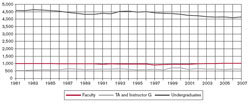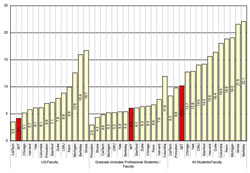
| Vol.
XX No.
2 November / December 2007 |
| contents |
| Printable Version |
Should MIT Increase the Size of the Faculty?
We announced some time ago a plan to return the MIT undergraduate population to ~4,500 from the present number of ~4,100. As many of our faculty colleagues may remember, our undergraduate population was 4,495 as recently as 1996 (see Chart 1). Since that time, housing availability has restricted our undergraduate population in order to provide all freshmen with on-campus housing, while not displacing the many upper-class students who desire to live on campus. This housing demand resulted in a decrease in the undergraduate population to 4,112 by 2004, even though it has always been MIT’s intention to return to an undergraduate population size of ~4,500. Before returning to the traditional size of our undergraduate student body, a careful assessment of what needs to be done to maintain the same quality of education and student services without increasing the workload of our faculty and staff is necessary. This article briefly focuses on the potential student/faculty impact of these plans. It is important to point out that returning to our undergraduate base of ~4,500 students will occur gradually as we develop our housing capacity and our ability to preserve a quality educational experience for our students, inside and outside the classroom.
An argument has been made that, since we plan to “increase” our undergraduate student body by 10%, we should increase our faculty size by 10%.
We will try to explain here that, although this position is understandable at first sight, a more careful analysis may not justify this across-the-board approach. However, modest increases in faculty size and/or instructional staff may need to be considered. Modest increases in faculty size to respond to strategic directions will also be considered.

Faculty, TAs/Instructors, Undergraduates (click on image to enlarge)
1. We taught ~4,500 undergraduates with ~1,000 faculty as recently as 1996. While the undergraduate student population decreased starting in 1997, and reached its lowest point in 2004, the number of faculty lines was not reduced. In fact, there has been a marked increase in individuals in instructional roles over the past decade. In 1996, when the undergraduate population was 4,495, the faculty size was 960 and the number of teaching assistants (including instructor G) was 580. In 2006, the undergraduate population was 4,066, the faculty size was 992 and the number of teaching assistants (including instructor G) was 610, representing a 9.5% decrease in undergraduates, and a concurrent 3.3% increase in faculty, and a 5.2% increase in the number of teaching assistants during this 10-year period (see Chart 1).
2. Our undergraduate student (UG)-to-faculty ratio is one of the lowest among our peer institutions (see Chart 2). In AY2005-2006 (the most recent year for which peer data is available), our UG/faculty ratio was 4.13, higher than Caltech’s 3.48, but significantly lower than those for Harvard (5.74), Yale (6.09), Columbia (6.11), Princeton (6.87), Stanford (7.10), CMU (8.81), and Berkeley (15.93), to cite just a few. These kinds of comparisons are never perfect, but they do provide some idea of relative workload.
3. We have already enrolled a class size that would bring the undergraduate population closer to ~4,500. In steady state, about 1,125 students would be enrolling each year. This year’s freshman class has 1,067 students, so we are close to the targeted number of freshmen. Moreover, as the data in Chart 1 indicates, the reduction from ~4,500 to ~4,100 took place from 1996 to 2004. Growth to a larger class size would occur gradually as we are able to absorb a larger class.
| Back to top |
Needless to say, we cannot be too mathematical about this issue. We do teach some subjects differently today than 10 years ago, and we do need to assess and pay special attention to the staffing of these subjects. Outside the classroom experience, it is important to recognize that MIT has made substantial investments in the last 10 years in areas such as student life, educational technology, and health services. These investments have resulted in enhancements that have been welcomed by our students and faculty, and are probably partly responsible for our higher admission yields and stronger student approval. Maintaining quality and continuously assessing and improving the experience of our students are an important MIT commitment.
Another argument we have heard is that, even though the undergraduate student population decreased without a reduction in the number of faculty lines, the graduate student population increased and the latter requires an increase of our faculty size.
While it is true that our graduate student body has increased, this increase results from decisions made by departments and programs and not by any centrally coordinated efforts across the Institute. In other words, academic units that admit graduate students decide by themselves how many graduate students to admit. They typically make these decisions based on a variety of important considerations, among them available financial resources for research assistants, teaching assistants, and fellowships, as well as the number of faculty available to teach and mentor graduate students in the academic unit.
It is important to point out that 68% of the increase in graduate students over the period 1995-2006 (i.e., 521 of the 762 additional students) occurred in Doctoral programs, with 88% (i.e., 456 out of 521) of that increase occurring in the School of Engineering. The increase in graduate students in the School of Science during this period was 6.0% (i.e., 46 out of 762), mostly in its Doctoral programs, while the increase in Sloan was 17.3% (i.e., 132 out of 762), mostly in its Masters programs. The increase in graduate students in the School of Engineering was 63.4% (i.e., 483 out of 762). The remaining 13.2% increase was in SAP (9.4%), SHASS (-3.8%) and Whitaker (7.6%).
Lastly, the argument has been made that we have many exciting research opportunities, and the only way to undertake all these exciting opportunities is by increasing the size of our faculty. While MIT has been hiring at a rate of ~50 faculty members per year for many years, we still do not tap all of the currently available faculty resources. Every year there are ~50 additional faculty positions which are left unfilled. Beyond these already committed but unfilled faculty positions, we believe we all agree that we cannot do everything, and that the Institute needs to make deliberate decisions on new, exciting areas to pursue at the expense of other areas the Institute will not pursue. We need to be strategic when selecting the areas in which we hire our faculty and invest in our future; we need to hire the faculty that will create the disciplines, research, and innovations of the future. At the same time, we need to satisfy the demands of our students for the subjects and fields they came to MIT to learn.
In short, we are not increasing the size of our undergraduate population from a base of 4,100 to a new level of 4,500. We are simply restoring the number of undergraduates MIT has had historically over many years. This will be done gradually. We will assess individual situations that may require additional staffing on a case-by-case basis. We are committed to maintaining the quality of the education we provide, and to continuously assess and improve the educational experience of our students.
| Back to top | |
| Send your comments |
| home this issue archives editorial board contact us faculty website |
